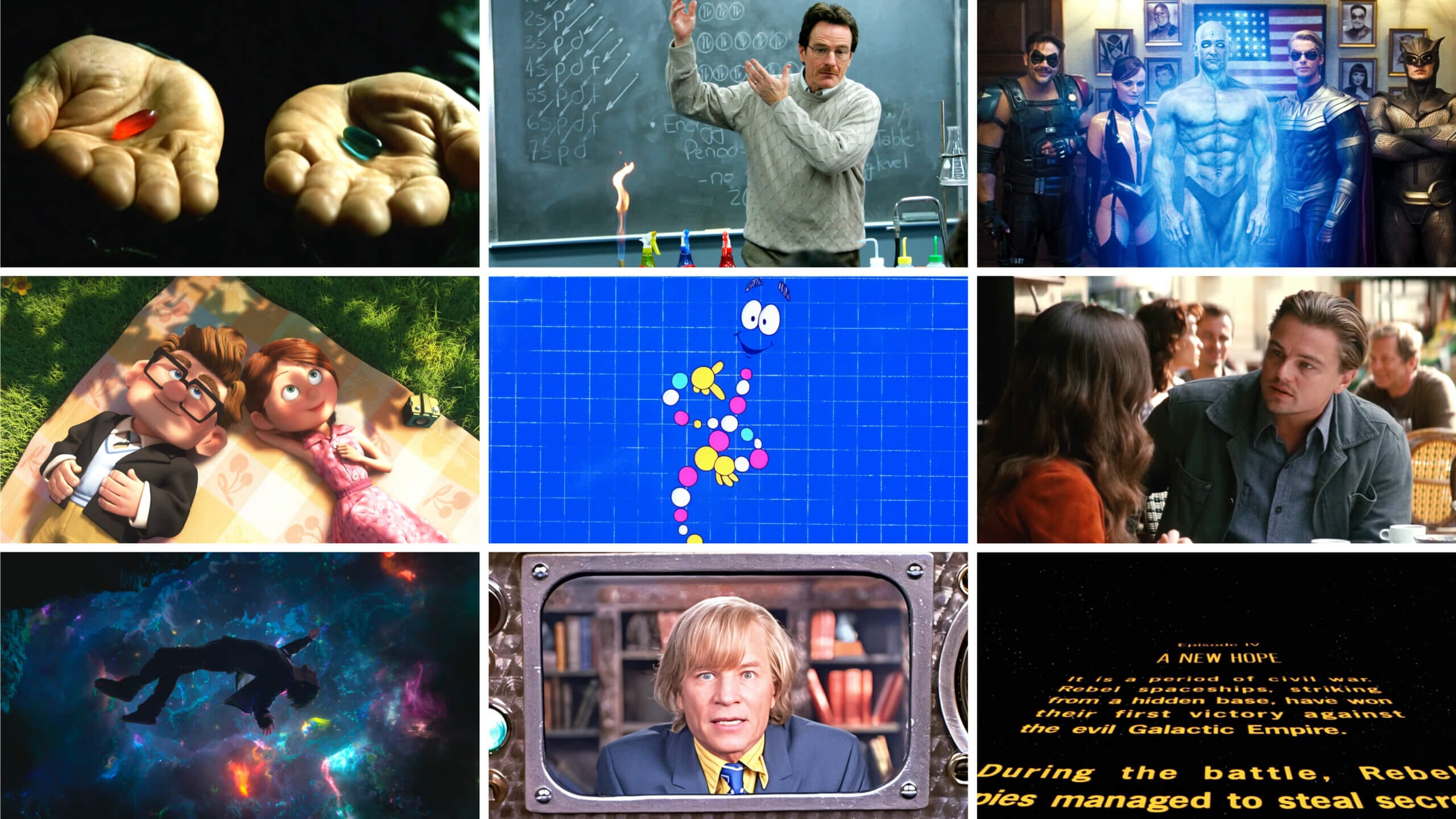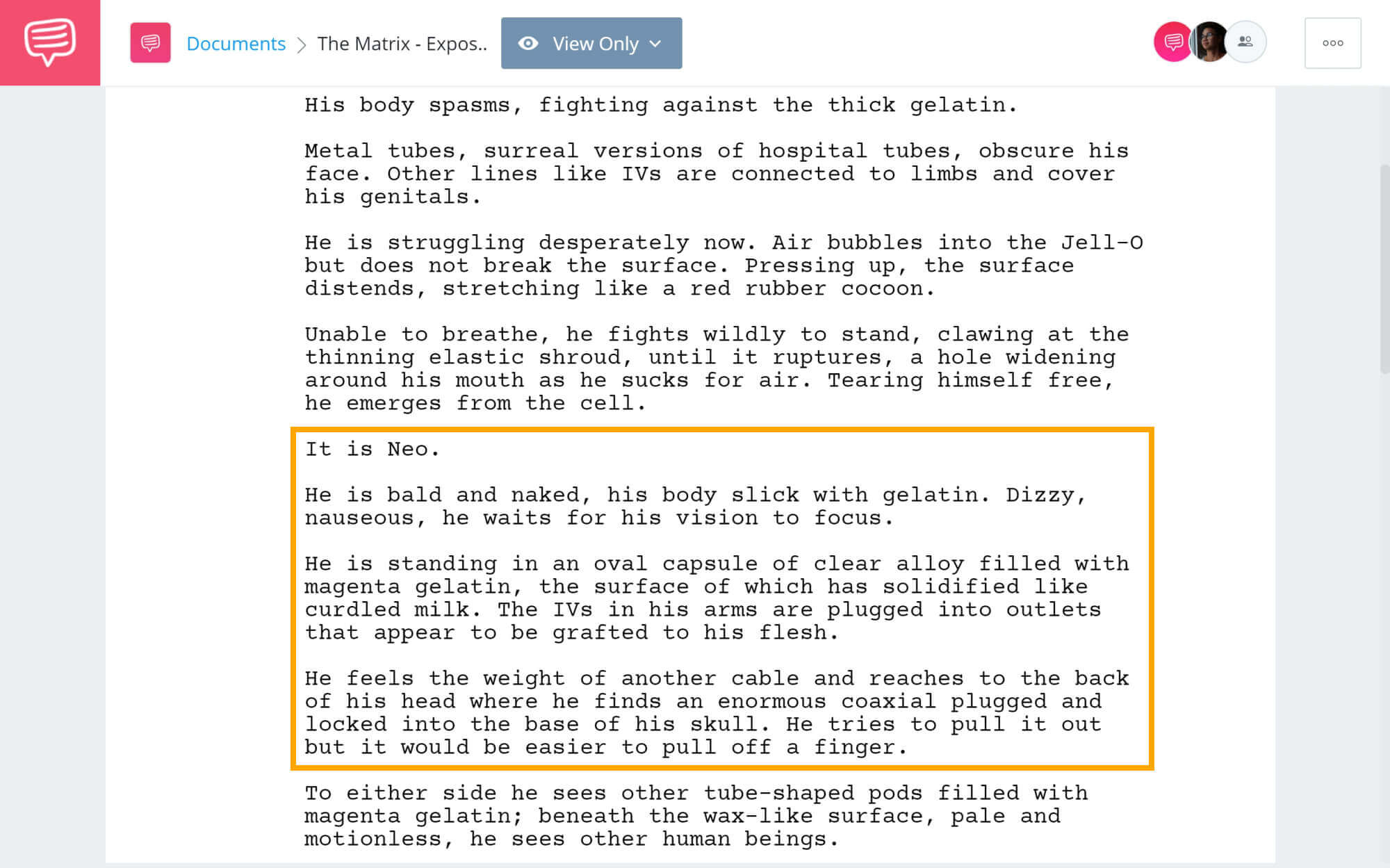One of the most basic functions of every film is to communicate information over a length of time to an audience. How this film is communicated often determines how engaged an audience may be. One of the most difficult types of information to weave naturally into a story is exposition. What is exposition? In this article, we’ll define exposition and take a look at a few examples of how exposition in film can be implemented without disengaging an audience.
Exposition Definition
First, let’s define exposition
Exposition can be delivered through many vehicles, but all serve a basic function. What does exposition mean? Before we dive into the means of implementing it into a script, let’s first establish an exposition definition.EXPOSITION DEFINITION
What is exposition?
Exposition is a comprehensive description or explanation to get across an idea. It is a device used in television, films, poetry, music, and plays. Exposition in literature is a writer’s way to give background information to the audience about the characters and setting of the story. This exposition definition applies directly to film. Which can be dialogue, narration, or even visual information that helps the audience better understand what is going on in the story.
What is exposition used for?
- Reveal theme
- Describe the story world
- Entice audience curiosity
- Establish the rules of a film
- Reveal more about character
What is exposition of a Story
The purpose of exposition
There are many secrets to writing great exposition in a screenplay. But they all rely on its main function. The purpose of exposition is to reveal details around the circumstances that surround a film’s narrative. This can be character traits, motivations, background information or themes that all allow the audience to further comprehend the central narrative of a film.
Expository "info dumps" often get a bad rep when they aren't used well. But it can be a necessary component for a film to function. Using the right tools gives exposition meaning.
Exposition in film can often be difficult to implement naturally. Too little and the audience becomes confused — too much and the audience becomes disengaged. The right amount of exposition is usually a product of a filmmaker trusting the audience's ability to be able to put things together. It's also recognizing what information is absolutely necessary for them to know.
This video by Lessons from the Screenplay examines how Ex Machina executes the balance of information perfectly to keep the audience engaged throughout.
Exposition Examples in Ex Machina
Take note of how writer/director Alex Garland cut pages of expository material from the final cut of the film. He did this because he trusted the ability of the audience to put things together. This is an important aspect that is often overlooked. It can result in information being spoon-fed to audiences through lengthy dialogue scenes or completely unnatural conversations.
So how exactly do filmmakers implement this information naturally into a film while keeping the narrative engaging? The first way is through visuals — using what we see instead of what we hear.
Related Posts
Visual Exposition Examples
Define exposition with visuals
Visual exposition is often more engaging, but also more difficult to pull off. Sometimes it is used through the mise-en-scene of a scene. For example, a character's bedroom often reveals their personality traits. Let's say a character really loves rock 'n' roll music. Having them say, "I love rock 'n' roll" would get the job done. But having their room decorated with posters, albums, and concert tickets would be more organic.
Using visual aids is among our list of tips in this video breakdown of how to write exposition into a screenplay. Watch how Jurassic Park makes the genius decision to reveal scientific jargon and concepts through an educational video.
How to Define Exposition in Film
This scene is extremely efficient at communicating information. But not every narrative has the luxury of introducing a concept in a matter-of-fact video. To incorporate crucial information into a film visually and organically, it is up to the script must first entice curiosity in the audience.
A film that does this brilliantly is The Matrix. If you read The Matrix screenplay, you'll see how it uses visual information when it answers the film’s most burning question: “What is the Matrix?”
We brought The Matrix screenplay into the StudioBinder's screenwriting software to break it down. In this scene, Neo and the audience first encounter “the real world.”
The scene enables the audience to understand the central narrative of the film and how the world of the film operates.
What's the Exposition in The Matrix • Read Full Scene
This video breaks down various action sequences that also serve as visual story and plot information.
The Matrix • Exposition Examples
As shown in the video essay, The Matrix does not only use visuals to exposit key information. But there are other means of communicating the plot details of a story that utilizes what a character says to the audience or to the other characters.
Related Posts
What is exposition through voice over?
Exposition meaning in narration
Beyond the visual elements of a film, filmmakers also utilize sound to communicate information. One of the most efficient ways to do this is through voice over narration.
When it is executed well, narration can connect an audience to a film’s protagonist while communicating vast amounts of information over a short amount of time.
Few filmmakers do narration better than Martin Scorsese. Voice over narration is a common aspect of Scorsese’s directing style and screenplays.
In this scene from Goodfellas, Scorsese uses voice over narration to establish Henry's backstory, introduce the power of the mob, and highlight Henry's motivations. This is done all within three minutes.
Goodfellas makes a valid case for voiceover in film
For more exposition examples in The Goodfellas script, download and read the entire screenplay. By using voice over narration, filmmakers have a way to directly communicate exactly what they want to the audience. This can be both a good and bad thing depending on how you write a voice-over in a screenplay.
Narration can often spoon-feed audiences information or disengage them completely. It is important to use narration with restraint. This means letting it complement the visuals rather than take over the scene completely.
WHAT IS EXPOSITION IN DIALOGUE?
Deliver exposition through dialogue
One of the more engaging ways to include vital info is through dialogue. What is exposition in dialogue used for?
Dialogue is one of the more difficult ways to lay out the details of a story. Poor dialogue is often criticized for being unnatural. When used naturally, it can be incredibly effective.
Take a look at this video that analyzes exposition examples in dialogue — both poor and great examples that make a scene memorable.
What's exposition in dialogue?
As you can see, good expository dialogue has to be motivated. When it isn’t, it becomes "on the nose" and can distract or disengage an audience. Writing realistic dialogue can be difficult, but can also be the most natural and effective way to communicate information to an audience.
Related Posts
UP NEXT
Explore more literary devices
Exposition is just one of many literary devices and types of figurative language, including flashback, peripeteia, and story beats. If you're a writer and want to develop your craft fully, do yourself a favor and continue this exploration. The next article on literary devices is a gateway to many of these tools that help add substance and style to any type of written work.

